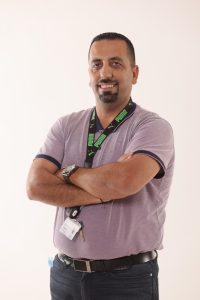
My name is Wael Shomar, and I am the Head of the Nurses in the emergency room and the Head of the workers’ committee.
I started working back in 2000 as a student in the neonatal ward. After passing the government exam and registering as a nurse, I worked in the ICU for 15 years. Later, I became responsible for preparing the hospital to deal with major events, such as an earthquake, big road accidents, a war, etc. In 2017, I was appointed as Head Nurse at the ER.

Working at the ER is very difficult. The violence rate in our community is higher than in other regions. Also, the number of patients who come to the ER keeps increasing yearly. In 2017, we received 65,000 patients. In 2020 the number increased to 70,000. This year, we expect to get more than 90,000 patients. That’s why it’s very important to expand the ER and restructure our building. According to the standards of the Ministry of Health, we would need more than 2,600sqm, while we currently have less than 900sqm. We offer a broad spectrum of trauma services closer to people’s homes. Alongside the two other hospitals in the city, we must serve the area, including Nazareth and the surrounding villages: approximately 300,000 people. We must take every case and give the best for each patient.
The patients go to the reception office, where we take their details. Then, they wait to be called by the triage nurse. In the triage room, we assess each case and establish the priority required: the most complex cases always take priority. We have one bed in the triage room, while the standards of the Ministry of Health require more than three beds. In the orthopaedics emergency room, we receive between 70 and 100 patients. It’s a very small space with only two beds. The shock room is one of the most important rooms in the hospital. It has many mechanical ventilations, sonography, etc. We use it for CPR (Cardiopulmonary resuscitation), cerebrovascular accidents, etc.; all the serious trauma victims come here. Around 3% of our patients come to this room every day. We have two beds, but according to the Ministry of Health, we need two more.
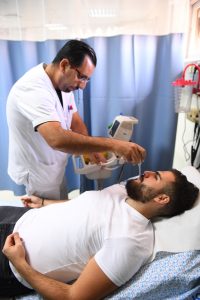
Wael Shomar with a patient
I want to serve our community. My mission is to serve every patient with compassion. What’s special is that people trust us; people believe in the hospital and what we give. Patients receive fast and good treatment. Despite all the financial challenges and the small ER, my colleagues and I love to come to work and continue the work that started over 160 years ago.
5 This is the message we have heard from him and declare to you: God is light; in him there is no darkness at all. 6 If we claim to have fellowship with him and yet walk in the darkness, we lie and do not live out the truth. 7 But if we walk in the light, as he is in the light, we have fellowship with one another, and the blood of Jesus, his Son, purifies us from all sin.
8 If we claim to be without sin, we deceive ourselves and the truth is not in us. 9 If we confess our sins, he is faithful and just and will forgive us our sins and purify us from all unrighteousness. 10 If we claim we have not sinned, we make him out to be a liar and his word is not in us. (1 John 1:5-10)
How difficult it is when the electricity is cut off for us and we are surrounded by complete darkness, unable to do any work whatsoever… But when the electricity returns, the darkness disappears and the light comes that helps us to do the usual things.
Here the Apostle John mentions that darkness and light cannot exist together at the same time and place. Likewise, the believer in Christ is likened to the one who walks by the light. He must also act according to the light of Christ. His life and actions must reflect the light of Christ, who dwells within him, to others.
In the second part of the reading, the apostle urges us to confess our sins because God is faithful. He will forgive us all our sins and purify us from every sin, when we return to Him with true and faithful repentance.
Questions:
1. How can I walk in the light with God and other people this Lent?
2. What areas of my life do I need to invite the light of God to shine on as I journey towards Easter this year?
The Nazareth Hospital has been part of Nana’s life ever since the day she was born. She was not only born there, just like her mother, but also gave birth to her three sons there.
Her maternal grandparents lived in a house between the hospital and the Anglican cemetery where Dr Vartan and his children are buried. Nana would often visit them in the afternoons when they would be hosting teatime following Arabic lessons to the expatriates who worked at the hospital. Her grandparents also had the honour to meet all hospital directors as far as Dr Bathgate. Nana’s mother also became a committed volunteer since 1982, and later the coordinator of the volunteer ladies’ group.
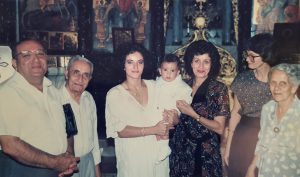
Najla (third from the left) holding her son with her parents, her grandparents and Jenny Coward, a friend with the essence of a sister, in the Greek Orthodox Church in Nazareth.
Sometimes people ask her: “Do you know this person who worked at the hospital a long time ago?” And she says: “Yes, I know them, but not from working at the hospital. I met them because they became friends with my grandparents and aunt.”
14 “You are the light of the world. A town built on a hill cannot be hidden. 15 Neither do people light a lamp and put it under a bowl. Instead they put it on its stand, and it gives light to everyone in the house. 16 In the same way, let your light shine before others, that they may see your good deeds and glorify your Father in heaven. (Matthew 5:14-16)
Would you light a lamp and then place it in a cupboard? Probably not. It might seem obvious, but Jesus reminds us here that light is supposed to shine.
As disciples of Jesus, we have been entrusted to carry the “light of the world” within us. In this passage, we’re reminded of our responsibility to let our light shine so that others might find the hope and refuge they’re looking for amid the storms of life. Like a lighthouse guiding the boats to the safety of a harbour.
However, we should not forget that the true light that shines from within us is Jesus. After welcoming Him as our Saviour, we actively follow His teachings in the Bible and seek Him through prayer.
By being open in our love for Jesus and sharing the good news, we are letting our light shine. Like a city on a hill seen from miles away, we should be a light that others can see. This is the vision of the Nazareth Hospital – the hospital on the hill – to shine the healing light of Jesus in his hometown.
When other people see our good actions, we set an example for others. But we should never aim to gain personal credit: our purpose is to glorify God instead. Only as we point others to the light of Christ, will they be able to move from darkness to light and glorify our Father in Heaven.
Christine Farah, originally from the North of England, moved to Nazareth when she married Elias, a Nazarene. Her journey at the Nazareth Trust began in 2009, when she helped establish the SERVE programme, which launched in 2010. Christine worked as the SERVE Director for many years until the COVID-19 pandemic changed everything…
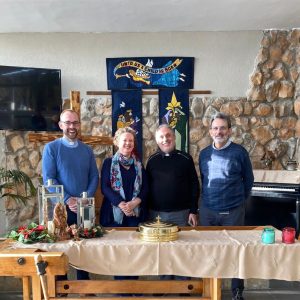
Christine with other members from the Pastoral Care team in the hospital’s chapel
John 8:12
12 When Jesus spoke again to the people, he said, “I am the light of the world. Whoever follows me will never walk in darkness, but will have the light of life.”
John 9:1-5
As he went along, he saw a man blind from birth. 2 His disciples asked him, “Rabbi, who sinned, this man or his parents, that he was born blind?”
3 “Neither this man nor his parents sinned,” said Jesus, “but this happened so that the works of God might be displayed in him. 4 As long as it is day, we must do the works of him who sent me. Night is coming, when no one can work. 5 While I am in the world, I am the light of the world.”6 After saying this, he spit on the ground, made some mud with the saliva, and put it on the man’s eyes. 7 “Go,” he told him, “wash in the Pool of Siloam” (this word means “Sent”). So the man went and washed, and came home seeing.
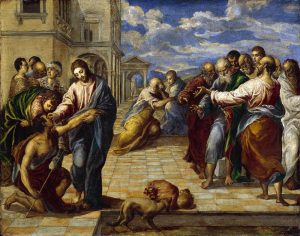
Healing of the Man Born Blind, painted by El Greco in 1567
There is an interesting connection between these two passages, not only that they are both in John’s gospel, but that as Jesus states that those who walk with him will never walk in darkness, he meets someone walking in darkness and transforms them.
The passage shows a man who had spent many years in darkness. We know this because he is described as someone who was blind from birth and has reached the age of maturity. He has never seen light before this encounter with Jesus and we can understand now why Jesus says he has been blind only that the works of God may be displayed in him. This is a living example of the earlier saying of Jesus – that whoever follows him will no longer walk in darkness.
But what did it take for this man to be transformed in this way? There was actually very little for him to do, except to believe and obey. He allowed Jesus to put the mud on his eyes (not exactly what any one of us would expect in this situation) and then all he had to do was to go and wash. He took this walk in the dark – a darkness he was used to functioning in and which he could presumably navigate at least as far as the pool Jesus sent him to. But on arriving and washing there, his journey was transformed – he came back walking in the light, able to see.
So what does it mean for us this Lent to know Jesus as the Light of the World? This world is often a place of darkness and we may even experience darkness ourselves, internally. So how can we reach the light of Jesus? All this man had to do was to believe and obey. It took a little time, but through faith and obedience he was transformed and given the ability to walk in the light.
Lord, in this Lent period, give us the ability to trust you and obey your instruction. Give us your light in the darkness and help us to walk in your light and life each day. Amen.
“There was a man sent from God, whose name was John. He came as witness, to bear witness about the light, that all might believe through him. He was not the light, but came to bear witness about the light.” (John 1:8)
As we commence our Lenten journey of hope against darkness, we are introduced to the figure of John the Baptist. He is described by St John the Apostle as ‘a man sent by God as a witness, to bear witness to the Light that all might believe through him.’
He bore witness to the Light by the following actions:
John’s witness prepared the way of the Lord by making his paths straight and after he was put in prison by Herod Antipas, Jesus came to Galilee preaching the gospel of the kingdom of God, and saying, “The time is fulfilled, and the kingdom of God is at hand. Repent and believe the gospel.” (Mark 1: 14-15)
How desperately this message of repentance is needed today in the very same place that John the Baptist bore witness to the Light, where religious pride, hatred and vicious cycles of revenge are destroying Israeli and Palestinian communities alike.
As we continue our journey towards Easter this year,
1. How can I bear witness to the Light of Jesus Christ in the growing darkness in our world?
2. Bear fruit in keeping with repentance by changing my way of thinking and acting with the help of God’s Spirit?